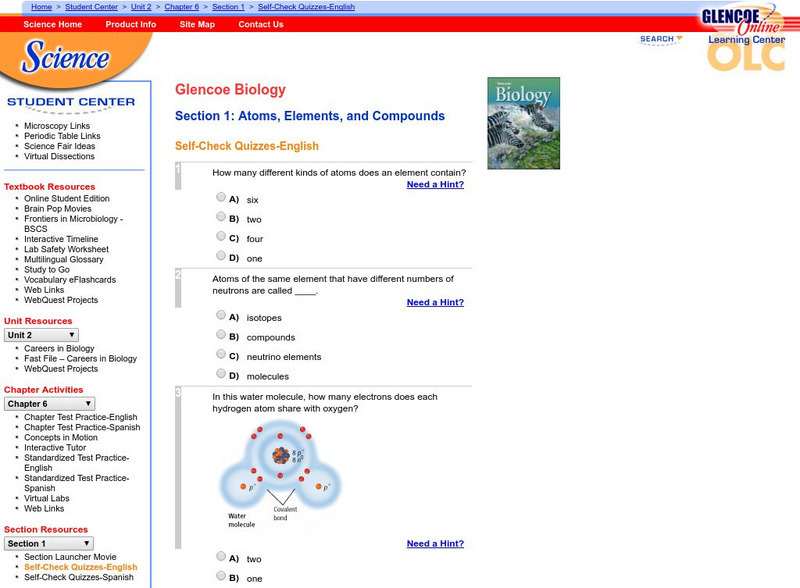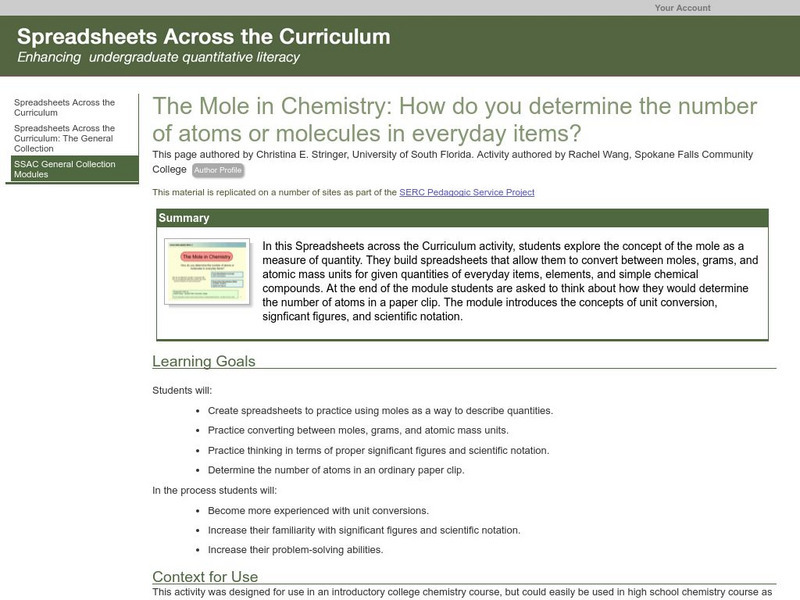ClassFlow
Class Flow: What Is Matter?
[Free Registration/Login Required] Discover the composition of matter and the relationship between matter, atoms, and elements. Students will learn the differences between elements and compounds, and how molecules are formed. Chemical...
Frostburg State University
General Chemistry Online: Atoms, Elements, and Ions Faq
Get the skinny on all things frequently asked about isotopes, subatomic particles and atomic theory. Find out what a "dalton" is or the difference between Na+ and Na.
Sophia Learning
Sophia: Valence Electrons and Core Electrons
Through a series of slide show presentations and a video lesson, strengthen your understanding of valence electrons. [2:46]
Khan Academy
Khan Academy: Biology: Chemistry of Life: Atomic Number,atomic Mass,and Isotopes
Learn the fundamental properties of atoms in this article. Understand the definition of atomic number, atomic mass, and isotopes. [6 min, 50 sec]
Wisc-Online
Wisc Online: Lewis Dot Structures of Covalent Compounds
Short slide show provides basic information about drawing Lewis dot structures for covalent compounds. Starts with anatomy of the atom, and then shows the relationship between atomic particles and the Periodic Table of Elements. Offers...
Other
Atoms in Motion: All Matter Is Made of Atoms
Atoms are very, very small. Atoms are so small that it is often said that there are as many atoms in a single grain of sand as there are grains of sand on all of the world's beaches - certainly a difficult thing to prove, but you get the...
Science4Fun
Science4 Fun: What Is Atom
Fun and interesting illustrated information on atoms including composition, elements, and history.
Science4Fun
Science4 Fun: Elements
Fun and interesting information about elements. Learn about the periodic table, how they are distinguished, and the different families of elements.
Purdue University
Purdue University: Elements, Compounds & Mixtures
Provides definitions and characteristics of elements, compounds, and mixtures, and gives an animated image of each.
BBC
Bbc: Gcse Bitesize: What Does the Periodic Table Tell Us About the Elements?
The number of protons in the atom of an element determines its place in the Periodic Table. The number of electrons in an atom is the same as the number of protons. These electrons are arranged in shells or 'energy levels' around the...
Simon Fraser University
Chem1 Virtual Textbook: Chemical Composition
Chemical composition is a section of a larger overview on Chemistry, covering a variety of aspects. This section focuses on elements, atoms, compounds, and structure. Examples, formulas, and pictures are provided.
McGraw Hill
Glencoe Biology: Atoms, Elements, and Compounds: Self Check Quiz
Try these five multiple-choice questions that help students review atoms, elements, and compounds. Each question has a hint and a self-checking feature.
Chem4kids
Chem4 Kids: Atoms: Neutrons
Students will find an explanation of the neutron particle located inside the atom's nucleus. Website also defines isotopes and the process of radioactive decay.
Science Education Resource Center at Carleton College
Serc: The Mole in Chemistry: Determining the Number of Atoms in Everyday Items
Students explore the concept of the mole as a measure of quantity. They build spreadsheets that allow them to convert between moles, grams, and atomic mass units for given quantities of everyday items, elements, and simple chemical...
Annenberg Foundation
Annenberg Learner: Interactives: The Periodic Table
An interactive website where students learn about the basics of an atom, periodic tables organization, and the structure and properties of matter. Module includes an introduction and five lessons that are followed by a quiz and an...
Ducksters
Ducksters: Chemistry for Kids: Elements: Manganese
Research the element manganese on this site by finding its chemistry including atomic weight, atom, uses, sources, name, and discovery. Plus properties and characteristics of manganese.
Ducksters
Ducksters: Chemistry for Kids: Elements: Plutonium
Find information about element plutonium such as its properties and characteristics. Also study its chemistry including atomic weight, atom, uses, sources, name, and discovery.
Ducksters
Ducksters: Chemistry for Kids: Elements: Boron
Study the element boron and its chemistry including atomic weight, atom, uses, sources, name, and discovery on this site. Plus properties and characteristics of this element.
Ducksters
Ducksters: Chemistry for Kids: Elements: Beryllium
Explore the element beryllium on this site. Learn about its chemistry including atomic weight, atom, uses, sources, name, and discovery as well as its properties and characteristics.
Ducksters
Ducksters: Chemistry for Kids: Elements: Tin
On this site, kids learn about the element tin and its chemistry including atomic weight, atom, uses, sources, name, and discovery. Also find the properties and characteristics of tin.
Ducksters
Ducksters: Chemistry for Kids: Elements: Sodium
Kids learn about the element sodium and its chemistry including atomic weight, atom, uses, sources, name, and discovery. Plus properties and characteristics of sodium are discussed.
Ducksters
Ducksters: Chemistry for Kids: Elements: Sulfur
Explore the properties and characteristics of sulfur on this site. Kids can learn about the element sulfur and its chemistry including atomic weight, atom, uses, sources, name, and discovery.
Ducksters
Ducksters: Chemistry for Kids: Elements: Silicon
Investigate the properties and characteristics of silicon. Students can study the element silicon and its chemistry including atomic weight, atom, uses, sources, name, and discovery.
Ducksters
Ducksters: Chemistry for Kids: Elements: Potassium
Study the properties and characteristics of potassium on this site. Learn about the element potassium and its chemistry including atomic weight, atom, uses, sources, name, and discovery.
Other popular searches
- Elements and Atoms
- Atoms Elements and Compounds
- Candy Atoms and Elements
- Science Elements and Atoms
- Physics Atoms and Elements
- Elements Molecules and Atoms
- Atoms, Elements, and Compounds
- Atoms, Elements and Compounds





















